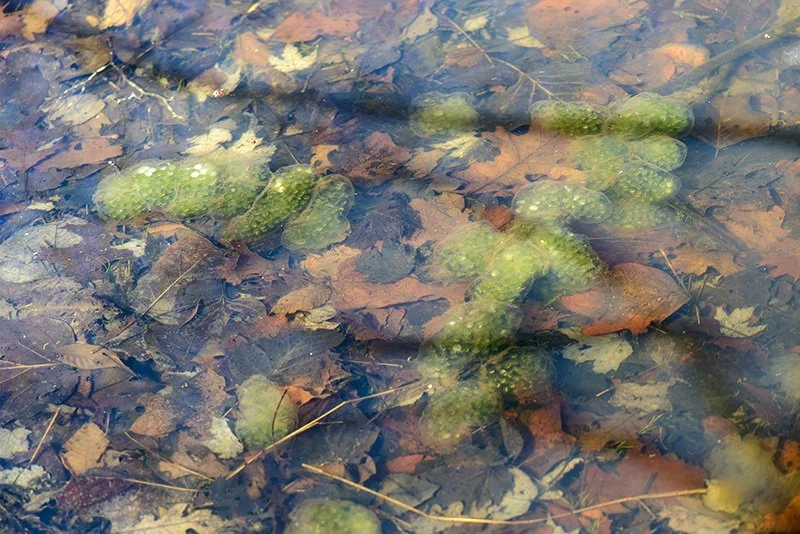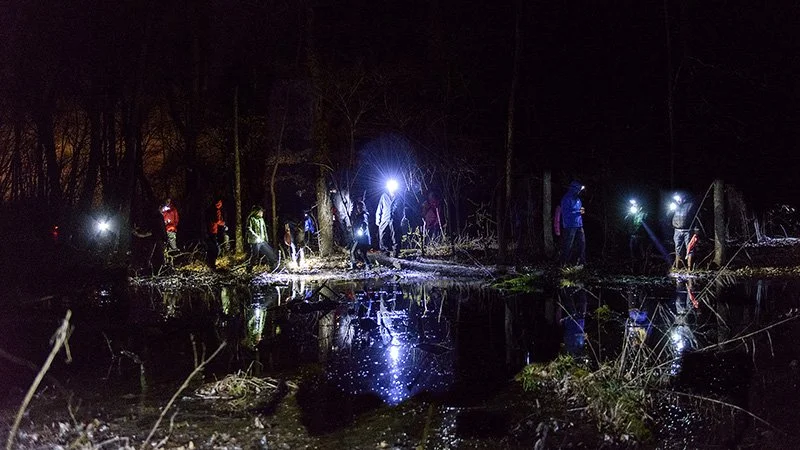Winters End 2024
By
Roger Hangarter
Distinguished Professor and Chancellors Professor Emeritus
Department of Biology, Indiana University
Woodland pond in mid-February.
In mid-February of each year I find myself looking forward to witnessing the end of winter. When the first warm (>50° F) rain of the new year arrives and darkness sets in, I grab my rain gear, headlamp, flashlight, and camera and head to a forest near where I live in the hope of witnessing the amazing spectacle of thousands of amphibians awakening. When entering the woods, the distinctive high-pitched calls of thumbnail-sized Spring peepers (Pseudacris crucifer) help guide me towards a pond. Upon approaching the pond, the deeper croaking of recently thawed male wood frogs begin to be heard among the peeper’s peeps and, at the ponds edge, my ears are confronted with a piercing chaotic chorus created by hundreds of peepers and wood frogs seemingly overjoyed by their release from a winter’s worth of muted frustration.
The warm rain also awakens more silent occupants of the woods, like Spotted Salamanders (Ambystoma maculatum) and their close relative, the blue-gray Jefferson Salamander (A. jeffersonianum). Both species are called mole salamanders because they spend most of their life in hidden in burrows under the forest undergrowth, but the first warm rain of the year draws them up to the forest floor where they make their way on their stubby legs through the wet leaf litter, the whole time guided by unseen signals (most likely chemical) that lead them back to the pond of their birth. Spotted Salamanders are among the largest salamander species in Indiana – reaching up to nine inches long – and they can live up to thirty years. The sausage-like bluish-black bodies of the adults are dotted with large bright yellow spots which are thought to warn potential predators of the presence of a neurotoxin produced by glands in their skin.
Adult Spotted Salamander (Ambystoma maculatum)
Salamanders have a long history in mythology and lore. Long before science recognized the differences between amphibians and reptiles, Theophrastus referred to salamanders as lizards that emerge when it rains. Some Native American tribes associated salamanders with the beginning of Spring and saw them as signs of renewal and healing, presumably because, like lizards, they can lose their tails to escape predators and then regenerate the lost body part. In Renaissance times, salamanders were often associated with fire, which likely stems from the fact that some salamander species hibernate among rotting logs so when wood is brought indoors and put on the fire, salamanders sometime “mysteriously” appeared among the flames. Their emergence from fire was likened to the Phoenix of Greek mythology that cyclically regenerates or is otherwise born again, akin to the Native American folkloric belief of the salamanders association with the start of Spring. Consistent with these and other tales, the annual reappearance of Spotted Salamanders across Eastern North America is still seen by many as a harbinger of Spring and foretells the annual arrival of renewed growth that is essential for sustaining forest biodiversity.
As the rainy night progresses and more and more salamanders join the march to the ponds, I must carefully watch my every step to avoid stepping on them. Scanning across the forest floor with my headlamp reveals glimmers from their wet skin as the salamanders seek their birthing pond with the singular goal of reproducing. At the edge of the pond, the light from my headlamp reveals reflections from hundreds of wood frog eyes. Aiming my light to peer down into the pond water exposes a writhing stew of salamanders, Spring Peepers, Wood Frogs, Red-Spotted newts, tadpoles, and a variety of other pond creatures. All night the pond will churn with these alien-like creatures engaged in a wet-and-wild orgy where mating is their primary objective. To mate, male frogs grasp females behind their heads in a tight grip called amplexus. In the mating frenzy, diminutive peepers often grasp at the larger Wood Frogs and Wood Frogs grasp at peepers. Frogs can also be seen clasped to salamanders and newts. The Spotted Salamanders, which do not engage in physical contact to mate, ignore the amorous frogs until they eventually release their grip and continue their quest for a gravid female of their own species.
Spotted salamanders in a mating frenzy.
The loud, slippery amphibian orgy lasts for just a few nights. During the day, the same ponds can seem devoid of life since most of the amphibians shun light and hide in silence among the leaf litter on the bottom of the pond. During the nightly orgies, the male salamanders deposit fuzzy white packets of sperm, called spermatophores, on the bottom of the pond. Females passing over the spermatophores can pick them up with their cloaca and fertilize the eggs they carry inside themselves.
Eyes of male wood frogs waiting for females to arrive at the pond.
After releasing their spermatophores, the males head back to the forest while the females stay behind to lay their eggs. The eggs emerge coated with a sticky jelly that anchors them to underwater stems and branches in clusters containing up to 100 eggs. After laying their eggs, the females return to the forest where they will remain until the following year. The sticky jelly masses swell with water and, in a few weeks, oblong pea-sized embryos can be seen inside each egg capsule. The individual egg capsules take on a light green color as the algae, Oophila amblystomatis, proliferates in the capsules with the embryos. The association of the alga with the salamander eggs is thought to be mutualistic. The algae produce oxygen by photosynthesis, which helps fuel the embryos’ metabolism and development beyond what would be possible by relying on diffusion of oxygen through the protective jelly alone. In turn, the embryos produce nitrogen that the algae can use. As the embryos and algae continue to grow, the egg masses begin to resemble jelly-coated clusters of emerald-green grapes.
Spotted salamander egg masses with symbiotic algae in the egg capsules.
In another few weeks, petite tadpole salamanders with feathery gills hatch and immediately begin searching for food, eating anything that moves and fits in their mouths. Only about 2% of the tadpoles survive the many predators that live in the pond (including cannibalism by other salamander larvae). By fall, the survivors will resorb their gills, transform into their adult form, and then migrate into the forest in search of an underground home. They will reach sexually maturity in about six years, and then, with the first warm rains of late winter, they will join in the annual migration to breed in their birth pond.
Spotted salamander larva.
Woodland ponds and the life they support are important components of deciduous forest ecosystems. Many inhabitants of the ponds obtain their energy and nutrition, directly or indirectly, from the biomass of leaves that accumulated in the pondwater during summer and fall. Woodland ponds are often ephemeral and dry out by late summer, necessitating that many of the pond organisms spend part of their life cycle in the forest. Like the leaves that fell into the ponds, these organisms eventually die and decompose in the forest, and the elements of their biomass are again available for growth of new plant biomass that replenishes the life of the forest and its ponds.
When I moved to Indiana in 1995 the appearance of the first warm rain and amphibian orgy typically coincided with the mid-March Spring-break at Indiana University, where I am an emeriti professor of biology. These days, trees, and wildflowers in the northern hemisphere leaf-out and bud about two to three weeks earlier than Thoreau noted 160 years ago when he lived by Waldon Pond. Similarly, the onset of winter also occurrs weeks later. Thus, animals that hibernate during winter, like groundhogs, Spotted Salamanders, spring peepers, and Wood frogs, begin hibernating later in the fall and emerge earlier in the spring, unaware that the shortening of their dormant period is a threat to their long-established lifecycles.
Last January (2023), the NY Times reported data showing global temperatures over the last 8 years have been the hottest on record. This January we learned that 2023 was the hottest year on record and on February 7, the NY Times reported that “January was the eighth month in a row in which global temperatures blew past previous records.” Stories about temperature extremes, floods, wildfires, prolonged droughts, and other disruptive ecological changes resulting from human reliance on a fossil fuel economy appear daily so it should not be surprising to learn that the Census Bureau estimated that 2.5 million people were forced from their homes in the United States by weather-related disasters in 2023. Inevitably, even far more wildlife has been forced from their homes.
The night of the amphibians is something I have witnessed each year for decades and I remain in awe of it all, but it is now mid-February 2024, and winter in south-central Indiana was even milder than the last few years. My usual excitement about experiencing one of the most impressive natural displays, the awakening of the amphibians, is tarnished by a growing sense of dread as winters continue shortening with each passing year. I still cling to hope that the salamanders regenerative and healing powers be enough for them to continue to live and reproduce, but I fear that the pageant of the annual amphibian reawakening will soon become little more than a pre-Anthropocene myth told to children in a deeply diminished future world in which we will have knowingly ended the season formerly known as winter.
Group of people out to observe the amphibian mating event to welcome the end of winter before winters have truely ended.






